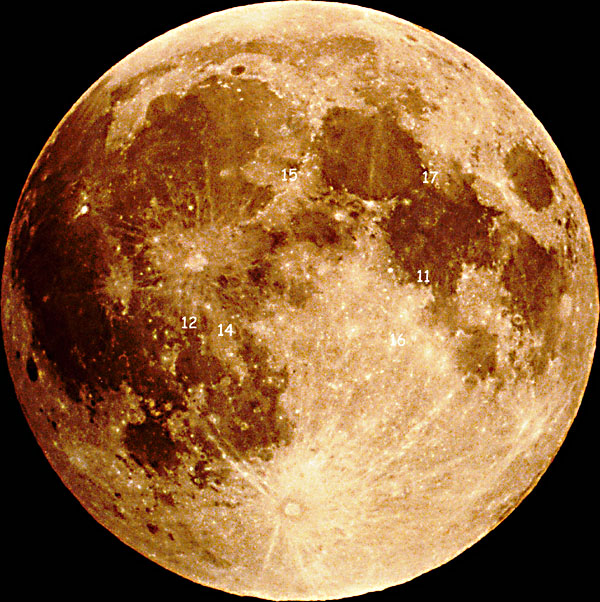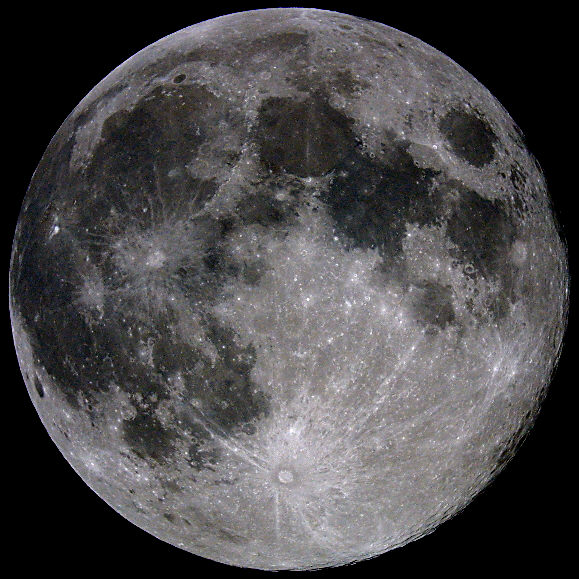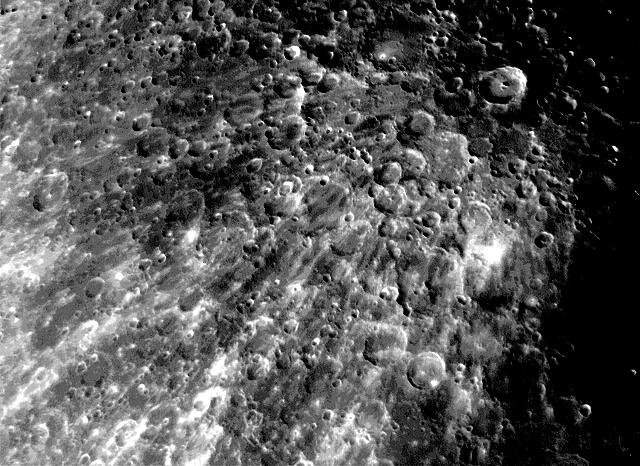
A Very Full Full-Moon and the Apollo Landings
A full Moon does not photograph well. The Moonscape is very evenly lit by the Sun and the relief does not show up clearly. Features tend to be very bland with little contrast. It's like taking a photo out of a plane over the Central Oman gravel plains; say, over the Qarn Alam area. Nevertheless it is the only time that you get to see the whole shebang in one go. The photo below was taken less than half an hour before a Lunar eclipse, on the evening of 9th January 2001. Since the Moon and the Sun are on opposite sides of the Earth during an eclipse, the whole face is fully lit. The image was darkened and contrast enhanced to bring up the Moon's features somewhat, but still, nothing beats oblique lighting. To spark up some interest, I have added the locations of the Apollo manned landings that took place around 1970. What a long time ago! At the time there was a lot of talk about money being wasted on useless science while millions are starving on planet Earth. Unfortunately, of course, poverty is relative. The billions of $ saved since then may have helped the poor somewhat, but there will of course always be many people at the bottom of the social ladder (by definition) and their lot will always seem decrepit to the average person. This is unlikely to change even a thousand years from now. Perhaps it remains wise to continue to spend money on "useless" science (and even opera!), in moderation, so as to lift the human spirit every now and again. The first humans to set foot on the Moon were aboard Apollo 11, on the edge of the Sea of Tranquility (Mare Tranquillitatis). Everyone who watched the landing back then, live on fuzzy black and white TV, still remembers exactly where he was at the time and the anxiety of the moment. Subsequent landings went onto progressively rougher ground, but nevertheless public interest waned. Even though the TV went onto full colour.

Notice that Apollo 13 is missing? That's the one with "Houston, we have a problem" and never did make it to a landing on the Moon.
Next: What colour is the Moon anyway? It appears that many astronomers state that the Moon is the colour of charcoal, not green cheeze. When we look at the full Moon, our perception is doctored by the fact that the surrounding sky is black. Nevertheless, to colour balance the above photo I used the exact same settings as the daylight photo below, taken on the same film roll. The colour balance of the photo below looks normal, and the only conclusion that I can come to is that the Moon looks like a brownish, weathered (by cosmic rays?), desert landscape, or else it is something to do with the film emulsion and processing. The Moon photo was darkened and its contrast enhanced on a gray-scale basis, colour settings unchanged, but this does not mean that no colour shift was introduced inadvertently somewhere along the chain. It seems that at least Fuji 800 ends up giving brownish Moon photos. A photo taken by my latest toy, a Canon EOS D30 digital camera, with a reputation for superb colour rendition does show it as gray, below.
Oh, by the way, the photo above shows the PDO Oil & Gas Exhibition Centre and Planetarium. Click on the photo for a brief history of how the planetarium came into being and how it ended up looking like it does.
Here is a D30 shot of the full Moon, 8"SCT at f6.3:

It does look charcoal gray, and sharper than the film photo! An interesting aside: those hundreds-of-km long rays that you see emanating from the crater Tycho in the above photo become most prominent during full Moon. Under oblique lighting they are hardly visible. So I waited for a night with semi-oblique lighting and bagged the image below, using an SBIG 237 CCD this time, in monochrome, since it's all supposed to be charcoal gray anyway ;-) The trick is to wait for a night when the lighting is oblique enough to show the relief of the craters well, but with the rays still clearly visible.

The image is a composite of 4 (trying to sharpen it up) and is upside-down compared to the preceeding D30 photo, so that you may better appreciate the KAPOW-SPLAT! origin of the rays.
So what does one conclude in film vs digital? The SBIG 237 CCD uses a frame-transfer electronic shutter. Consequently, since there is nothing that moves mechanically, it does not cause camera shake and is probably the instrument of choice for high magnifications. But colour images through the RGB filtering process are a pain, and totally impractical for the Moon (you get colour fringing/noise because of atmospheric shimmer distorting different parts of the image differently). The EOS D30 delivers full colour instantly, has a huge pixel array (2160x1440) and a high effective ISO at 1600 to keep exposures brief. When you use mirror pre-release, the shutter does not seem to shake things much. I'll have to check it out when the seeing is better in winter. Film does look very dead for lunar/planetary photos. Mind you, film is still king for wide angle Milky Way photos.
For more stuff return to Samir's Home